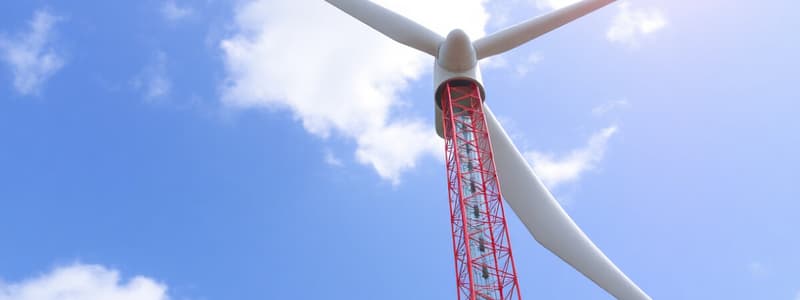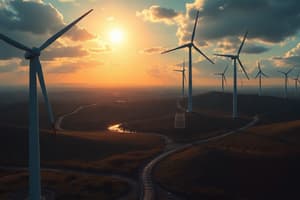Podcast
Questions and Answers
What is one of the main challenges associated with utilizing the best wind resources in the U.S.?
What is one of the main challenges associated with utilizing the best wind resources in the U.S.?
- Excessive noise generated by wind turbines
- High initial costs of turbine components
- Limited land availability for installation
- Distance from population centers requiring new transmission lines (correct)
How is wind energy characterized with regard to its output?
How is wind energy characterized with regard to its output?
- It varies significantly based on geographic location (correct)
- It only generates power during the summer months
- It is consistently reliable throughout the day
- It is most productive during peak grid demand hours
Which of the following factors contributes to less variability in wind power output offshore compared to onshore?
Which of the following factors contributes to less variability in wind power output offshore compared to onshore?
- Presence of more obstacles and surface roughness
- Wind speeds are generally stronger near the surface (correct)
- Shorter fetch areas resulting in turbulent winds
- Higher temperatures leading to increased wind flow
What is the primary component of wind energy production costs in the U.S.?
What is the primary component of wind energy production costs in the U.S.?
How has the production tax credit (PTC) affected wind energy development in the U.S.?
How has the production tax credit (PTC) affected wind energy development in the U.S.?
What is the function of the blades with adjustable pitch in a wind turbine?
What is the function of the blades with adjustable pitch in a wind turbine?
What is the cut-in speed in wind turbine operations?
What is the cut-in speed in wind turbine operations?
Which component of a wind turbine is responsible for measuring wind direction and speed?
Which component of a wind turbine is responsible for measuring wind direction and speed?
What is the general rule of thumb for spacing turbines in a wind farm?
What is the general rule of thumb for spacing turbines in a wind farm?
How do wind farms manage to operate with reduced personnel?
How do wind farms manage to operate with reduced personnel?
Why are turbine outputs variable with wind speed?
Why are turbine outputs variable with wind speed?
What occurs when wind speeds exceed the maximum threshold for a wind turbine?
What occurs when wind speeds exceed the maximum threshold for a wind turbine?
Which component converts the collected power output into a format compatible with the electrical grid?
Which component converts the collected power output into a format compatible with the electrical grid?
What is a major disadvantage of vertical axis turbines?
What is a major disadvantage of vertical axis turbines?
Which equation accurately describes the power in the wind passing through a circular area swept by a wind turbine?
Which equation accurately describes the power in the wind passing through a circular area swept by a wind turbine?
What limits the total power that can be extracted from wind by a turbine as stated by the Betz limit?
What limits the total power that can be extracted from wind by a turbine as stated by the Betz limit?
Which of the following describes a significant advantage of horizontal axis turbines?
Which of the following describes a significant advantage of horizontal axis turbines?
In assessing wind resources, what is an important factor to consider?
In assessing wind resources, what is an important factor to consider?
What is a consideration related to the economics of wind energy?
What is a consideration related to the economics of wind energy?
What is one of the historical uses of wind energy prior to modern electricity generation?
What is one of the historical uses of wind energy prior to modern electricity generation?
What is a potential impact of expanding wind energy use in the United States?
What is a potential impact of expanding wind energy use in the United States?
Flashcards
Wind Farm Output Variability
Wind Farm Output Variability
Wind power output fluctuates significantly, even in areas with high wind resources. This inconsistency can be mitigated by strategically locating wind farms apart or utilizing offshore locations with more consistent winds.
Wind Farm Location (Offshore)
Wind Farm Location (Offshore)
Offshore wind farms benefit from a larger area of consistently strong winds due to the lack of surface obstructions.
Wind Farm Costs
Wind Farm Costs
The significant costs of building and maintaining a wind farm include capital investment, fixed operation and maintenance (O&M), land lease, permitting, and installation.
Production Tax Credit (PTC)
Production Tax Credit (PTC)
Signup and view all the flashcards
Wind Energy Variability
Wind Energy Variability
Signup and view all the flashcards
What is wind turbine pitch?
What is wind turbine pitch?
Signup and view all the flashcards
How does a wind farm minimize wind wake effects?
How does a wind farm minimize wind wake effects?
Signup and view all the flashcards
Cut-in speed
Cut-in speed
Signup and view all the flashcards
What is the purpose of a wind vane?
What is the purpose of a wind vane?
Signup and view all the flashcards
What does a wind turbine's power curve show?
What does a wind turbine's power curve show?
Signup and view all the flashcards
How does a wind turbine shut down?
How does a wind turbine shut down?
Signup and view all the flashcards
Why do wind turbines need yaw systems?
Why do wind turbines need yaw systems?
Signup and view all the flashcards
What is a nacelle?
What is a nacelle?
Signup and view all the flashcards
What is wind energy?
What is wind energy?
Signup and view all the flashcards
What is the Betz Limit?
What is the Betz Limit?
Signup and view all the flashcards
Name two types of wind turbines.
Name two types of wind turbines.
Signup and view all the flashcards
What are some advantages of vertical axis turbines?
What are some advantages of vertical axis turbines?
Signup and view all the flashcards
What are some disadvantages of vertical axis turbines?
What are some disadvantages of vertical axis turbines?
Signup and view all the flashcards
What's the power equation for wind energy?
What's the power equation for wind energy?
Signup and view all the flashcards
How is wind energy affected by the environment?
How is wind energy affected by the environment?
Signup and view all the flashcards
How is wind energy used?
How is wind energy used?
Signup and view all the flashcards
Study Notes
Wind Energy Overview
- Wind energy has been used by humans for at least 5000 B.C.
- Windmills were early precursors to modern wind turbines.
- Modern wind turbines operate on the same principle of extracting power from wind to turn a turbine.
- This process generates electricity.
Lecture Outline
1. Wind Energy Over Time
- Wind energy is one of the oldest forms of energy used by mankind.
- Sailing
- Grain milling
- Water pumping
- Milling wood
- Two basic turbine designs exist:
- Vertical axis turbines
- Advantages: Omnidirectional, can be installed in small spaces
- Disadvantages: Height limits power output
- Horizontal axis turbines
- Advantages: Omnidirectional, can be built tall with large blades, resulting in higher power output.
- Vertical axis turbines
2. Wind Power
- Power in wind passing through a circular area is calculated by a formula:
- Power = 1/2 x Air Density x Circular Area Radius x Wind velocity cubed
3. Betz Limit
- Only a fraction of wind power can be extracted to produce electricity.
- The maximum extractable power is 59% (Betz Limit).
- If all power were extracted, there would be no air movement on the other side of the turbine.
4. Blade Lift vs Drag
- Wind turbine blades have a teardrop shape for better lift.
- The angled blades cause faster wind over the top, creating a pressure differential that lifts the blades.
- Pitch controls the blade angle and thus affects power output.
- Drag counteracts lift, so a balance is needed.
5. Practical Limits on Blade Number
- One blade: 51% efficiency, higher vibration
- Three blades: 55% efficiency, less vibration, and better
- Betz Limit: 59% efficiency
- Increasing the number of blades beyond three generally does not increase efficiency significantly.
6. Wind Turbine Mechanics
- Main parts: Blades, rotor, brake, transmission, drive shaft, gears, electric generator (stator and rotor), yaw system, nacelle, wind vane, anemometer, tower.
7. Wind Capacity vs Output
- Power output varies with wind speed (power curve).
- Cut-in speed: Minimum wind speed for generating power.
- Maximum output: Wind speeds beyond a certain level may need to shut down the turbine to prevent damage.
- Efficiency varies based on speed.
8. Wind Farm Layout
- Turbine placement is optimized to minimize wind interference from other turbines.
- Spacing guidelines exist to minimize wind "wake" effect.
- Wind farms require less personnel and fuel than other power sources.
- Automated systems and remote monitoring are common.
9. Wind Resource vs Wind Farm Output
- Best locations for wind farms in the U.S.: Interior regions, mountain ridges, and offshore.
- Long transmission lines may be needed to bring power from remote locations.
10. Wind Economics
- Main costs: Capital costs (turbine, equipment, installation), O&M (maintenance, repairs).
- Variable costs are low, as fuel is free.
- Other costs: Land lease, permitting, and installation.
- Cost reductions are important as the wind industry scales.
- Government incentives, such as the Production Tax Credit (PTC), encourage wind development. This is a fluctuating incentive.
Studying That Suits You
Use AI to generate personalized quizzes and flashcards to suit your learning preferences.





